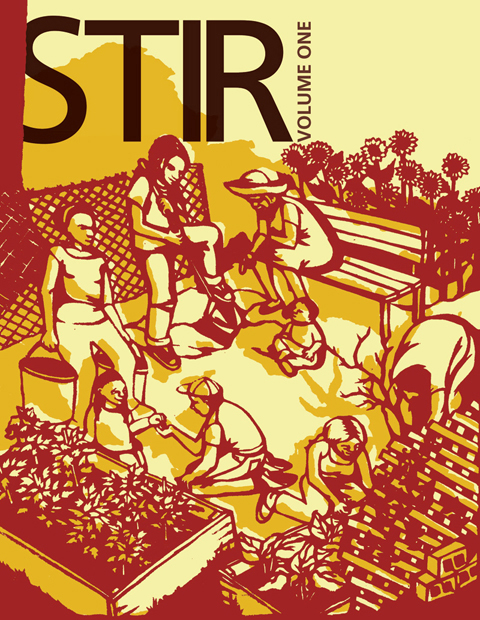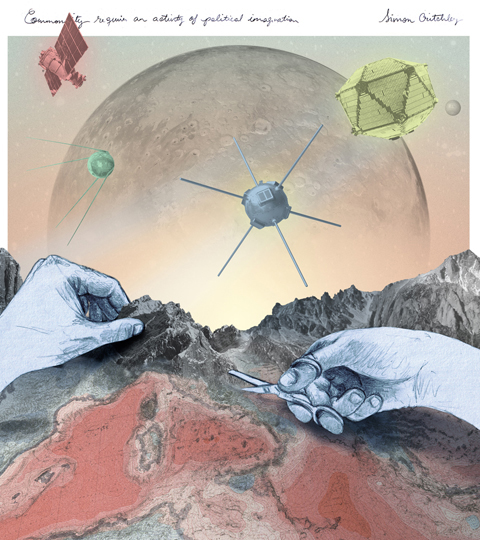
STIR Vol.1 cover by Bec Young.
New magazine STIR carries the strap line ANGER. ANALYSIS. ACTION. For anyone disillusioned with the current state of affairs it’s a must read collection of articles, interviews and radio shows which question the direction in which our supposedly ‘civilised’ world is going. This weekend they take part in the Stoke Newington Literary Festival, chairing a discussion about ethical fashion at 12.30 on Sunday 9th June at the Town Hall.

STIR to Action book illustration by German Gullon.
Find STIR to Action online and now in print, as a volume of collected writings and interviews about co-operative and community-orientated alternatives, all accompanied by imaginative illustrations (many of which have been created by artists that will be familiar to Amelia’s Magazine readers). I spoke with founding editor Jonny Gordon-Farleigh.

Food Justice, illustration by Sarah Jayne-Morris.
Stir has made the leap from online to printed publication: first as the book, STIR Vol.1 and now as a print version of the magazine. What prompted the move and what has the journey to print been like? A steep learning curve?
I think all platforms – both online and offline – are really important and we are still publishing online but also as a quarterly print magazine. I think we need to use different platforms strategically and so I’m not going to say one is more important than the other. It’s obviously very difficult to publish time-sensitive articles in a quarterly magazine that only appears every three months. I like to think of our quarterly magazine as slow news – issues that need time to be properly analysed and understood and to also give space to develop potential alternatives. On the other hand, if a campaign group wants to publish a piece about an event or mobilisation next week then I will publish on the online blog and distribute via social media. We are also looking into publishing a small free paper with selected content from the online blog and print issue so it can reach places that don’t sell magazines, such as social enterprise co-working spaces. It has actually been a well-paced launch into print from building an online readership to building an offline community through events. I needed to know and felt we had the support before launching into print.

STIR illustration by Alex Charnley.
Was crowd funding easy to do? What have been the highs and lows of taking this route to publication?
Crowdfunding was an interesting process for so many reasons. Firstly, crowdfunding allows us to fund projects without appealing to wealthly individuals – philanthropists – and also avoids the restrictions and conditions of grant-making bodies. Also, it creates an international community of co-creators and contributors for your project: Those who couldn’t contribute financially, offered their skills as graphic designers and artists. We even launched the book at The Firebox because a campaign group (Counterfire) couldn’t give us money as they were fundraising themselves, but did have an amazing event space in Kings Cross. Crowdfunding also allows you to self-publish and this gives you control over the creative process. The biggest problem with self-publishing is distribution and this is something we need to seriously address. The publishing industry had a monopoly on this before the emergence of the internet but anyone will tell you that it’s still really difficult to distribute your own work. (Hell yeah! – Amelia) So finding ways of distributing the funded book was certainly challenging.

Wizard of Oz, STIR illustration by Edd Baldry.
How did you find the contributing illustrators, and what was the process of their contribution?
I had worked with a few of the contributing illustrators before – Edd Baldry and India Rose Harvey — and also knew a few from other publications like the Occupied Times (Alex Charnley). However, Twitter was very helpful in finding new illustrators (thanks for the tweet Amelia!!) and I would have to say most of them enthusiastically responded to a call-out on Twitter. The creative process was largely asking them to respond to the an article. We would then talk about the ideas and see what could work to represent the piece. Every artist is different and that’s what makes it so interesting.

STIR illustration by India Rose Harvey.
How did you decide on the content of STIR Vol.1? Who contributed and what have they written about?
The content for STIR Vol.1 was selected from two years’ worth of online publishing at www.stirtoaction.com and we chose the articles and interviews that really showcased the emerging community-led and co-operative alternatives in our food and finance systems. We then invited 10 artists to contribute original pieces of art for the printed publication (see above).
We had a whole range of contributors including an economist, David Boyle, from the New Economics Foundation who wrote about the disconnect between wealth and money and how we need to design and scale-up alternative forms of exchange such as local currencies. The philosopher and Defend the Right to Protest activist Nina Power analysed the London Riots of 2011 with a review of a new book that was published on the events. I also published a piece by Guppi Bola and Bethan Graham about food justice, why the food system is broken and what creative communities around London are doing to change it for the better. We also featured the story of the Real Food store in Exeter that came out of Transition Exeter and was funded through a community share scheme, as a look at the rise of new social enterprises. The founders of Co-opoly – the boardgame of co-operatives – wrote about their new creation and how Monopoly was originally created during the New Deal era in America to teach tenants how to deal with bad landlords.

STIR illustration by Alicja Falgowska.
Anger is a cornerstone of your creation, which is somewhat at odds with the positivity of the Transition Network, of which you are part. Why do you think it’s important to find an outlet for anger?
It’s an interesting question and I definitely think there is a case for anger. There is something almost admirable about the Transition Network’s early decision not to engage with what might be called antagonistic campaigns, but there has definitely been a significant shift recently — the ‘No’ campaign to Costa Coffee in Totnes was fully supported by Transition Town Totnes. Also, I think it’s important to say that ‘No’ campaigns are far more effective and likely to succeed if they are part of a positive effort – like the initiatives that make up the Transition Network.
Also, insisting on always being positive is problematic as it can become as counterproductive as being the constant bearer of bad news, an argument that Smartmeme – a creative campaign agency – make in STIR Vol.1. So I think it’s philosophically shallow to see anger as a deformative emotion, if it’s part of a campaign for change it can have a reformative effect. Anger without new political options can be dangerous and that’s why the positive work of the Transition Network is really important. It’s worth saying that anger only transforms into cynicism when we accept the false political choices we are given and give up on alternatives.

STIR magazine issue 01 2013.
Another point to make is that as the Transition Network scales-up and mainstreams itself, it will have to challenge the current distribution of resources and space. It is not good enough to say that you won’t shop at a multinational supermarket, when they are draining resources and space from the communities, distorting business rates, and making it far more difficult for community-owned shops to establish themselves.
This can also be explained by an interview with George Monbiot about land inequality and how UK land prices have gone up 10-12% in the last few years. The land buyers, in this instance, are city bankers who are using their bonuses to invest in land. This has made it ten times more difficult to use the land for alternative purposes, such as land co-operatives and community farms. We need to be angry about this and find ways of challenging land inequality and access if we going to be able to do the positive work that the Transition Network promotes.
On top of this, while the aspiration to generate your own energy is something we all should be pursuing, we also need to insist – through protest, direct action and lobbying — that the fossil fuel industries keep it in the ground. All of that positivity will be irrelevant if these industries are not disrupted by public action. Lastly, I’m very suspicious of categorising activists. It suggests that there is one kind of person who will do the negative work, such as lying on airport runways or occupying power stations, and then on the other side you have the people who do all the positive activity like community gardens and upcycling workshops. I think we have the capacity to do both but should always remember to do it for the fun of it!
Will there be a STIR Vol.2? If so what can we expect from it?
As we’ve launched a quarterly magazine, the STIR volumes will most likely be bi-annual. We publish so many unpredictable stories I couldn’t really say!
Where can people get hold of the publication?
We sell STIR Vol.1 in our online shop here, and readers can sign up for a subscription for the quarterly magazine here. Our quarterly magazine – STIR – is being sold in 30 shops across the UK (find stockists here) and we have just started working with an ethical distributor – INK – so potentially lots more in the near future. You can buy the first issue of our new magazine with this Amelia’s Magazine Special Discount offer: click here for 25% off cover price and free P&P (£2.95).
What are your hopes for 2013?
It would have to be to continue to collaborate with more social enterprises and co-ops in working towards bringing the ideas in the magazine into our communities.
Categories ,Alex Charnley, ,Alicja Falgowska, ,Bec Young, ,Bethan Graham, ,Co-opoly, ,Counterfire, ,Crowdfunding, ,David Boyle, ,Defend the Right to Protest, ,Edd Baldry, ,George Monbiot, ,German Gullon, ,Guppi Bola, ,India Rose Harvey, ,INK, ,Jonny Gordon-Farleigh, ,Kings Cross, ,London Riots, ,New Economics Foundation, ,Nina Power, ,Occupied Times, ,Real Food, ,Sarah Jayne Morris, ,Smartmeme, ,STIR, ,STIR to Action, ,STIR Vol.1, ,Stoke Newington Literary Festival, ,The Firebox, ,Totnes, ,Town Hall, ,Transition Exeter, ,Transition network, ,Transition Town Totnes, ,twitter
Similar Posts:
- 999 it’s time.
- ‘Local Food’: Rob Hopkins returns
- Brixton makes transition
- Saving Iceland
- Bank Holiday
